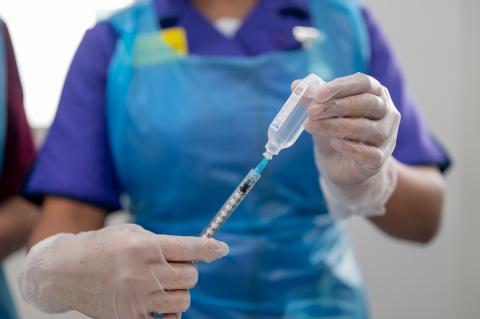Guy's and St Thomas' trial participants help to confirm flexible COVID-19 vaccine options
Wednesday 8 December 2021

The results of the Com-COV 2 study have shown that robust immune responses can be generated by giving two different COVID-19 vaccines.
Guy’s and St Thomas’ was a participating site in the study, which was led by researchers at the University of Oxford.
In a paper published in the Lancet, the results showed that:
- Giving a first dose of Oxford-AstraZeneca or Pfizer-BioNTech followed nine weeks later by a second dose of Novavax or Moderna COVID-19 vaccines generated a robust immune response.
- Oxford-AstraZeneca followed by Moderna or Novavax induced higher antibodies and T-cell responses in participants than two doses of Oxford-AstraZeneca.
- Pfizer-BioNTech followed by Moderna induced higher antibody and T-cell responses than two doses of Pfizer-BioNTech.
- Pfizer-BioNTech followed by Novavax induced lower antibody and T-cell responses than two doses of Pfizer-BioNTech. The combination still induced higher antibodies than two-doses of Oxford-AstraZeneca.
181 people took part in the trial at Guy’s and St Thomas’ with a total of 1,070 participants involved nationally. No safety concerns were raised in this study, across nine National Institute for Health Research-supported sites.
The results therefore support flexible use of these vaccines, which is crucial to help rapid deployment of the vaccines, especially in low- and middle-income countries where vaccine supply may be inconsistent.
Anna Goodman, consultant in infectious diseases at Guy’s and St Thomas’, was the local principal investigator for the study. She said: “We are so grateful to those who made the Com-COV2 trial possible - particularly those locally who gave up their time to participate in this study.
“It is almost exactly one year since the first COVID-19 vaccines were licensed for use, with vaccine regimes which involved receiving two doses of the same vaccine. So we were pleased when the first part of the Com-COV trial showed us that when we gave for example the Oxford-Astrazeneca followed four weeks later by Pfizer-BioNTech, we saw strong immune responses.
“It’s been really exciting in this follow up trial to see that we can combine a range of different vaccines with a nine week interval between doses and see excellent immune responses. It shows us for the first time that a strong immune response occurs when the two vaccines given are Oxford-Astrazeneca or Pfizer-BioNTech followed by Novavax or Moderna nine weeks later. This introduces new options for the first two doses of vaccine and globally could provide flexibility where it is needed.”
The study looked at various combinations of vaccines and was designed to show whether mixing vaccines is substantially worse than giving two doses of the same vaccine. The team compared the immune system responses to the gold-standard responses reported in previous clinical trials of each vaccine.
Professor Matthew Snape, Associate Professor in Paediatrics and Vaccinology at the University of Oxford, and Chief Investigator on the trial, said: “Thanks to studies such as these, we are now getting a more complete picture of how different COVID-19 vaccines can be used together in the same vaccine schedule.
“Encouragingly, all these schedules generated antibody concentrations above that of the licensed and effective two dose Oxford-AstraZeneca schedule. When it comes to cellular immunity, having a first dose of the Oxford-AstraZeneca vaccine followed by any of the other vaccines generates a particularly robust response.
“It’s only through the inspiring efforts of the Com-COV2 participants and study teams that we can generate these data; this will help get the world immunised against COVID-19 as quickly as possible.”
The study found that the first vaccine given made a difference to the immune response generated by the various schedules.
Blood samples taken from participants were tested for their effectiveness against the original ‘Wild-Type’ variant, as well as Beta and Delta variants. While it was observed that the vaccines’ efficacy against the variant strains had decreased, this was a consistent trend across the mixed schedules.
In addition, a significantly higher number of short-lived vaccine reactions were reported in volunteers who received a second dose of Moderna compared to those who received two doses of either Oxford-AstraZeneca or Pfizer-BioNTech.
Professor Matthew Snape said: “Using different types of vaccines within the same schedule as we have done here (for example mRNA vaccines, viral-vector vaccines or protein-based vaccines) is a relatively novel approach to immunisation.
“As well as providing evidence for flexibility in deployment, these results suggest this approach can also help generate better immune responses. This has implications beyond COVID-19, and will inform new approaches to immunisation against other diseases that are, as yet, not vaccine preventable.”
Professor Andrew Ustianowski, National Clinical Lead for the UK NIHR COVID Vaccine Research Programme, said: “We really cannot thank the volunteers and staff involved in studies such as Com-COV2 enough. The continued effort from everyone within the study helps to gather more important information on the immune response of these vaccine dose combinations.
“This is another set of positive findings discovered by the UK research community, supported by the NIHR, which could be applied globally. Results such as these will help to shape guidance nationally and internationally, allowing more populations to be better protected from COVID-19.”
Last updated: March 2022
Contact us
Media enquiries
Phone: 020 7188 5577
Email: [email protected]